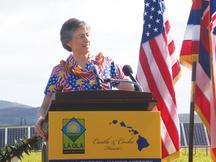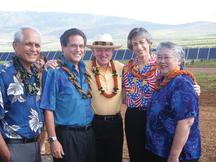Is Lanai's new solar farm part of the solution or just bright shining PR?
By Rob Parsons
Published in Maui Time Weekly
January 15, 2009
"I love her... I better be careful or I may not get anything approved."
- Billionaire developer David Murdock, speaking about Governor Linda Lingle at the blessing of La Ola solar installation on Lana'i
A sprawling white tent set out on the red dirt fields of Lanai kept the late morning sun off the guests gathered for the blessing of Hawaii's largest solar photovoltaic (PV) project to date. On the distant horizon towered Maui's dormant volcano, Haleakala, the "House of the Sun," a fitting backdrop to the 7,400 PV panels constructed on 10 acres of long-fallow pineapple land.
The state's top elected officials joined Lanai workers, high school students, hula performers, top brass from Castle & Cooke Inc. and Maui Electric Company (MECO) and interested onlookers in commemorating the opening of the solar farm, which is expected to produce up to 30 percent of the island's daily peak electricity.
Among those present was Governor Linda Lingle, who recently announced the ambitious Hawaii Clean Energy Initiative (HCEI). The initiative's aim is to have 70 percent of Hawaii's energy come from renewable sources by 2030. Moreover, of 1,100 megawatts (MW) of identified renewables to be integrated in the Hawaii Electric Company (HECO) grid, more than 700 MW are to be implemented within five years.
 |
 |
 |
Man, we didn't even have to Photoshop her this week.
In her comments to the crowd, Lingle predicted that Hawaii will survive world financial challenges better than other places, through a spirit of collaboration and aloha. She implored those present not to let the recent return to cheap oil and gas prices sway us from our path toward energy independence.
"This is not just about renewable energy," Lingle said. "It's about world peace. Wars are fought over resources, and 99 percent of Hawaii's oil is from foreign sources."
"No one owns the sun," she continued. "It is energy from heaven."
Lanai residents, who pay more than 50 cents per kilowatt hour (kWh)-not only the highest in Hawaii, but in all the United States-await anxiously to see if their bill-reduction prayers are answered. "It doesn't make me feel any better unless I see it financially," Lanaian Ron McComber told Honolulu Star-Bulletin reporter Jennifer Sudith.
Through a Public Utility Commission-approved power purchase agreement, MECO will buy the solar electric power initially for 27 cents/kWh, a figure that will rise to 33 cents/kWh for the last five years of the 25-year agreement. MECO president Ed Reinhardt told the Star-Bulletin he was unsure how much relief the solar farm will provide to Lanai residents, who also are still paying gasoline prices in excess of $5 per gallon.
The solar farm, with panels built and installed by SunPower Corp of Californina, is currently operating at less than half of an expected 1.2 MW capacity (the island's peak demand is 5MW). Though all the panels are in place, the $19 million project is still awaiting integration of three battery containers that will store power when the sun isn't shining.
SubPower General Manager Whitney Tomlin explained that each of the 7,400 6-by-12-foot panels contains 72 photovotaic "wafers" and is capable of producing 200 watts. The solar farm is actually 12 separate systems of 600 panels, positioned on the same axis to utilize the SunPower Tracker system, which tilts in relation to the sun's movement during the day, optimizing energy production.
"It's a beautiful day for solar," exclaimed Tomlin. He said MECO engineers on Maui can control the Lanai system remotely, a high-tech advantage that stands in stark contrast to the decades-old diesel power plant that provides most of Lanai's electricity. Two-dozen local workers with Keo Construction and Hawaiian Isle Diggers worked on the project, which provided $1 million in wages.
Governor Lingle was among several speakers who lavished praise on Castle & Cooke Chairman and Chief Executive Officer David Murdock. Lingle said she first met Murdock nearly 20 years ago, when she was mayor of Maui, and said he has the "purest of motives".
"I don't know anyone else who has invested more and made less," Lingle continued. "His vision is for a better world? for the Lanai children."
 |
 |
 |
Grippin' and grinnin..
Grippin' and grinnin.' Murdock, at 85, is among the Forbes Top 100 wealthiest Americans, landing at #84 last year with an estimated net worth of $4.5 billion. His fortune has roughly tripled over the past decade.
Once a high-school dropout, Murdock amassed a fortune in real estate dealings, and in 1985 took over the nearly bankrupt Castle & Cooke, which owned 98 percent of the land on Lanai. The entire island was previously purchased in 1922 by James Dole, president of Hawaii Pineapple Company.
Having spent $650 million in the acquisition, Murdock set out to re-create the island's economy, from a pineapple plantation to resort destination. The Lodge at Koele and Manele Bay hotels were constructed, both now operated as Four Seasons resorts.
Originally holding a 27 percent share in Castle & Cooke, Murdock upped his stake in the company's stock to 100 percent in 2000. He has helped turn Dole Food Company into one of the world's largest producers of fruits and vegetables, doing business in more than 90 countries.
Sporting a straw hat and lei, Murdock told last week's audience that Governor Lingle first sent him a letter urging him to do renewable energy on Lanai. One of the formidable obstacles was acquiring appropriate permitting for energy projects on agricultural lands.
He elicited laughter by continually referring to the length of time necessary for project planning. "Hawaii is the slowest pokey state in the world!" Murdock remarked, before adding, "I've always been noted for saying things that shouldn't be said."
Noting that bringing in oil depletes our local economy, Murdock continued, "I'm interested in creating jobs. We're not in the best of times. You're going to see hotels become very, very much less used than they are now."
"I want to get the wind farm going over there," he said. "How long will it take-three, four, five years?"
His reference was to the most ambitious project in the cornucopia of ideas for Hawaii's energy future, a proposal to link a 300-400MW wind farm on Lanai to Oahu by undersea cable. In June 2007, the Honolulu Advertiser reported that the massive $750 million project could provide as much as 15 to 20 percent of Oahu's total power needs.
The idea raised eyebrows at the 2008 state legislative session, where House Bill 2863 sought to fast track the permitting for the project. Renewable energy advocate and watchdog Life of the Land's Executive Director Henry Curtis called it "Castle & Cooke's Death of Democracy Bill."
"HB 2863 was written by Castle & Cooke and introduced by House Speaker Say," wrote Curtis, "to get around all meaningful public and state and county agency review of what would be the largest energy project in the history of the state."
Curtis argued that the largest projects should receive the most scrutiny, not the least. "This statewide grab for power and squashing of public involvement is arrogant, top-heavy, and mean-spirited," he wrote. "Renewable energy projects do not need to be exempted from all sane laws, rules and regulations."
Curtis, who last March labeled HB 2863 "the worst bill of the session," recently told me that the version that passed "was much more palatable" thanks to changes and amendments made by Sen. Roz Baker of Maui.
Renewable Energy News wrote in July 2008 that even with passage of two bills signed by Governor Lingle to streamline permitting on projects of 200MW or more, Murdock also asked her to declare a state of emergency, to allow her to suspend laws holding up project approvals. The story, "Oil Price Sparks Hawaiian Rush for Wind Farms," also noted proposals for more wind power on Maui, Oahu and Molokai.
In March 2008, UPC/First Wind, the parent company behind the Kaheawa Wind project on the ridge above Maalaea, announced its offer of $50 million toward the purchase of Molokai Ranch, which was beset by layoffs and threats to abandon utility operations. UPC hopes to recoup that investment by constructing a wind farm on the northwest tip of the island, at breezy Ilio Point. Like the Lanai proposal, the energy would be transmitted to Oahu by undersea cable.
MECO's December issue of "Consumer Lines," mailed to each ratepayer with the monthly bill, lists some of the components of the HCEI initiative: "Highlights of the agreement include: Constructing an undersea cable connecting Maui, Molokai, and Lanai into one electrical grid in order to transmit an additional 400 MW of wind power generated in Maui County to Oahu."
Transmitting electricity inter-island by undersea cable was first discussed in earnest back in the 1980s, when geothermal energy on the Big Island was thought to be a possible source of helping Hawaii towards energy independence. Fraught with myriad problems-including sulfurous emissions and native Hawaiian protests over drilling in Madame Pele-the idea never went anywhere.
The huge proposals also beg the question of whether it's a good idea to expand the state's electric grid, rather than learning to live within our means with locally available, on-island resources. With recent power outages on Oahu and Maui, one wonders what engineering safeguards there would be for such grandiose installations. MECO is still struggling to find the right methods of installing "shock absorbers" to compensate for the fluctuations in the Kaheawa wind energy delivery, and uses an average of one-third of the 30MW they are capable of producing.
Converting HECO and MECO's current systems to a "smart grid" capable of saving both energy and costs will be instrumental to meeting Hawaii's ambitious energy goals. In our rush to offset our overwhelming dependence on imported petroleum and other fuel sources, we will be wise not to proceed so hastily that we later look back and regret our choices.